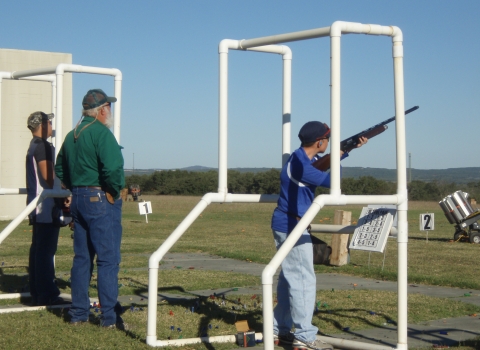Today, the U.S. Fish and Wildlife Service launched a nation-wide scientific study of wildlife refuges to investigate the cause of malformed frogs, toads and salamanders cropping up across the country and around the world. This summer, 43 refuges in 31 states from Alaska to Hawaii and Maryland to California will be studied by biologists and volunteers. These studies will focus on the impact of pollutants, especially pesticides, on amphibian malformations.
"Whats happening to these amphibians, and what their plight can tell us about our own environment are some of the questions the U.S. Fish and Wildlife Service plans to find out as we kick-off a first ever national amphibian survey of our refuge system," said Jamie Rappaport Clark, Director of the U.S. Fish and Wildlife Service.
"It seems fitting to launch this national amphibian study at Patuxent Research Refuge, where in the late 1960s, some of the key research was done to link DDT to reproductive problems in peregrine falcons, bald eagles and other raptors," said Director Clark. That research led the Environmental Protection Agency to ban the use of DDT in 1972.
In the last five years, an increasing number of frogs and toads with severe malformations have been observed throughout the United States and around the world. Surveys conducted in 1997 in the northeast and midwest found malformation rates ranging up to 17.9 percent at some of the refuges.
"Frog populations around the world are in a state of dramatic decline," said Director Clark. "When frogs and toads are either not found at all or are found with malformations on our national wildlife refuges, there is something wrong. We are here today to try to find out what that something is."
Amphibians are good indicators of significant environmental changes. Frogs and toads are highly sensitive to their environments, since they breathe at least partly through their skin. Scientists are studying a variety of possible causes for the declines and malformations, including disease and fungal infections, habitat loss, thinning ozone and increased ultraviolet radiation, pollution and other contaminant factors. The potential combined impact of some or all of these factors make it more difficult for scientists to determine the cause. The study is part of the Department of the Interiors Amphibian Initiative and includes other Interior agencies. A multi- agency taskforce consisting of the Departments of the Interior, Agriculture, Justice, Defense, State, the Environmental Protection Agency, the National Science Foundation and the Smithsonian Institution has been charged by the Clinton Administration to determine the causes of this trend of declines and malformations and to institute the appropriate actions to halt the disappearance of amphibians.
Today, eighteen species of frogs, toads and salamanders are listed as either threatened or endangered in the United States and Puerto Rico. Since 1989, scientists have documented four major "hot spots" for amphibian declines: western North America, Central America, northeast Australia and Puerto Rico. Some of the American declines have occurred in the most unlikely spots- the nations refuges, parks and wilderness areas.
In 1997, the Service started conducting surveys on some national wildlife refuges in the northeast and midwest. High malformation rates were found on four refuges in the midwest and nine refuges in the northeast, including Patuxent Research Refuge and Eastern Neck National Wildlife Refuge in Maryland and Eastern Shore National Wildlife Refuge in Virginia.
This year, scientists will be studying malformed frogs, toads and salamanders, as well as amphibian eggs, to determine the effect of pesticides on these species. Data acquired through the refuge studies done this year will be analyzed along with data gathered from other agencies on other suspected causes of decline and malformations. Building on the information gathered from these studies, and using other existing data, the Service will create a comprehensive map of hot spots nation-wide and provide concrete management guidelines for wildlife refuges and other land managers to address potential problems.
Director Clark encouraged the public to get involved in protecting amphibians. "Homeowners use up to 10 times more chemical pesticides per acre on their lawns than farmers use on crops. We can all help by choosing non-chemical weed controls whenever possible, minimizing our use of fertilizer and reducing our dependence on pesticides," said Clark. "If we all take these actions, we will not only be helping amphibians, but we will be taking care of our watersheds and other species like birds and fish as well."
The U.S. Fish and Wildlife Service is the principal Federal agency responsible for conserving, protecting and enhancing fish, wildlife and plants and their habitats for the continuing benefit of the American people. The Service manages the 93-million-acre National Wildlife Refuge System which encompasses more than 520 national wildlife refuges, thousands of small wetlands and other special management areas. It also operates 66 national fish hatcheries, 64 fishery resource offices and 78 ecological services field stations. The agency enforces Federal wildlife laws, administers the Endangered Species Act, manages migratory bird populations, restores nationally significant fisheries, conserves and restores wildlife habitat such as wetlands, and helps foreign governments with their conservation efforts. It also oversees the Federal Aid program that distributes hundreds of millions of dollars in excise taxes on fishing and hunting equipment to state fish and wildlife agencies.
-FWS-
* Attention Editor: B-roll of ponds with biologists conducting surveys, close-ups of healthy and malformed frogs and laboratory shots of biologists studying frogs, eggs and tad-poles, as well as pictures of healthy and malformed frogs will be available. The brochure, "Homeowners Guide to Protecting Frogs-Lawn and Garden Care" is available on our web-site at www. fws.gov">.


